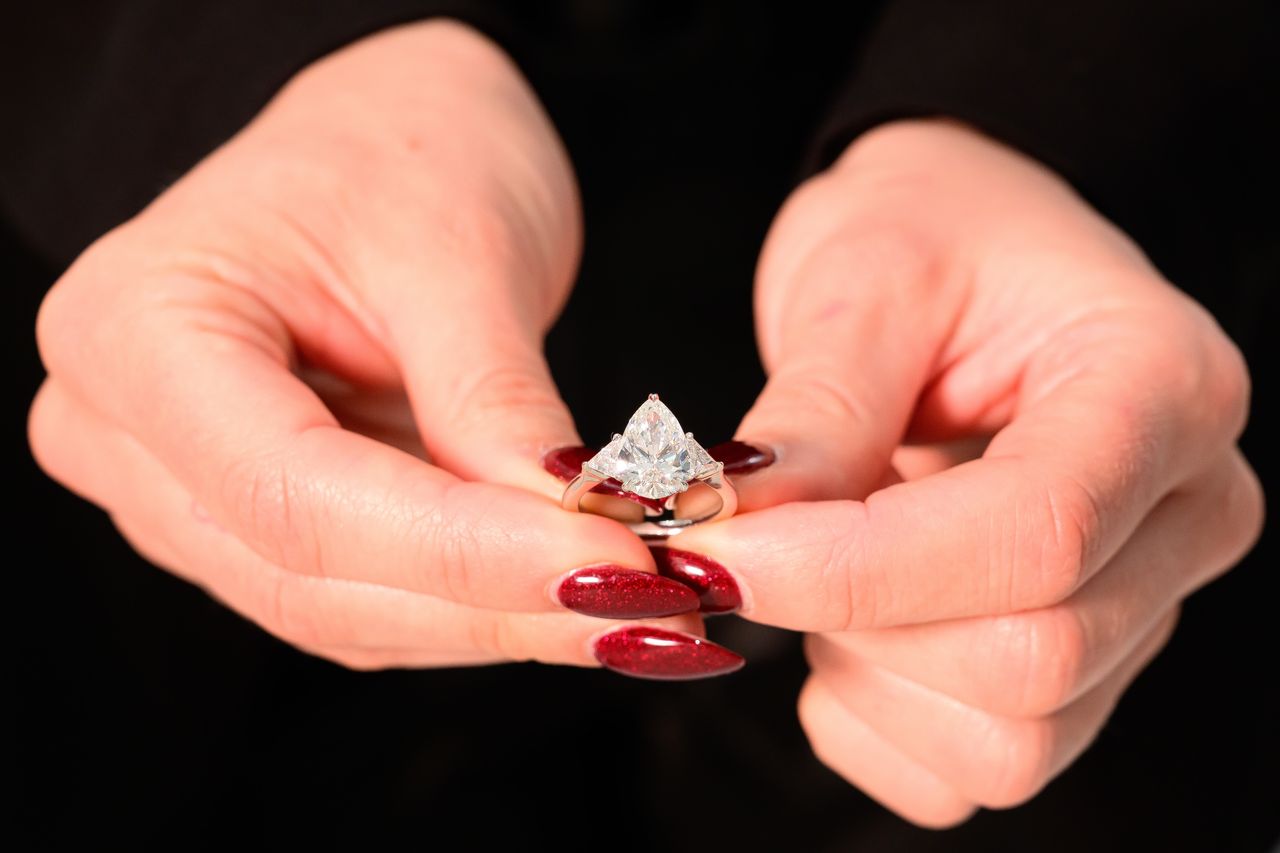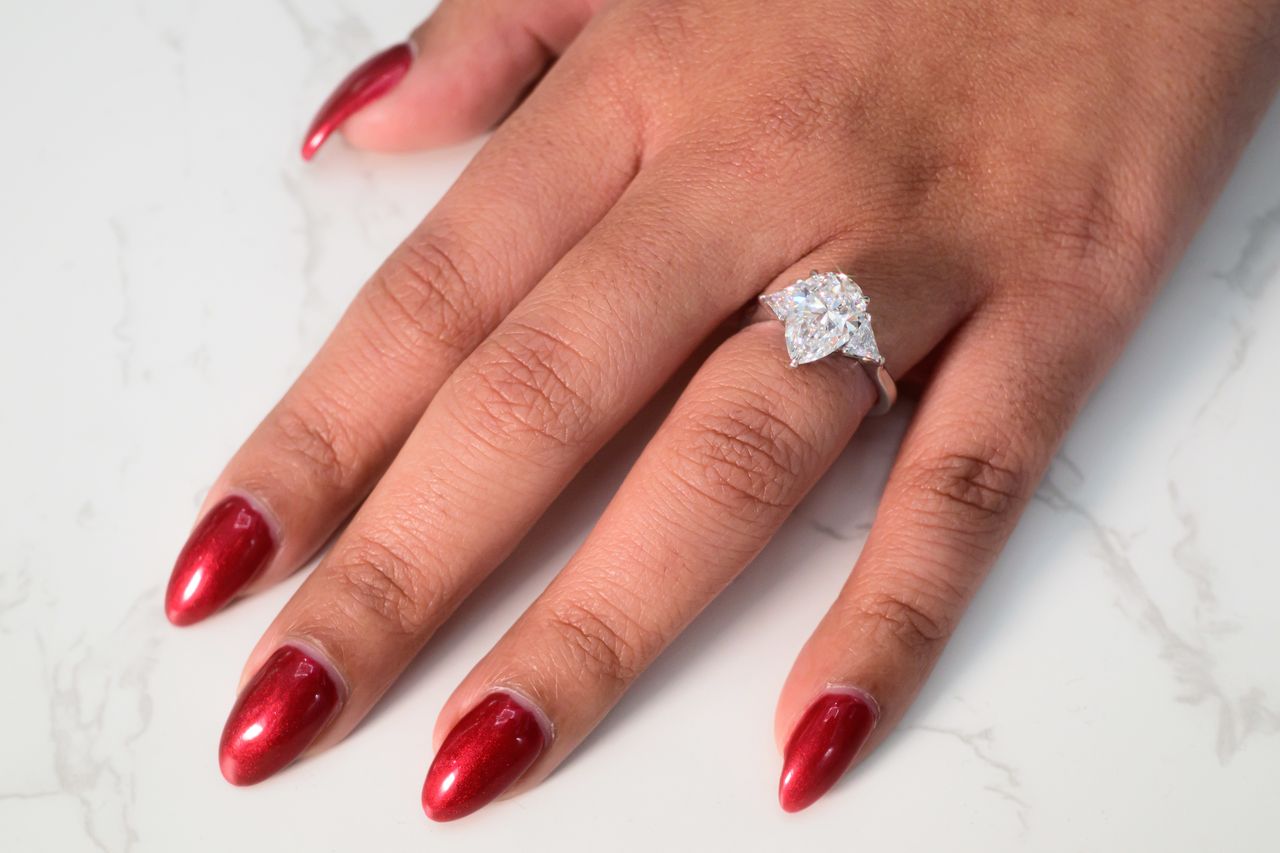The Embarrassment of Having to Explain Your ‘Monster’ Diamond Ring
Couples find that lab-grown diamonds make it cheaper to get engaged or upgrade to a bigger ring. But there are rocky moments.
Couples find that lab-grown diamonds make it cheaper to get engaged or upgrade to a bigger ring. But there are rocky moments.
Wedding planner Sterling Boulet has some advice for brides-to-be regarding lab-grown diamonds, which cost a fraction of the natural ones.
“If you’re trying to get your man to propose, they’ll propose faster if you offer this as an option,” says Boulet, of Raleigh, N.C. Recently, she adds, a friend’s fiancé “thanked me the next three times I saw him” for telling him about the cheaper lab-made option.
Man-made diamonds are catching on, despite some lingering stigma. This year was the first time that sales of lab-made and natural mined loose diamonds, primarily used as centre stones in engagement rings, were split evenly, according to data from Tenoris, a jewellery and diamond trend-analytics company.
The rise of lab-made stones, however, is bringing up quirks alongside the perks. Now that blingier engagement rings—above two or three carats—are more affordable, more people are dealing with the peculiarities of wearing rather large rocks.

Esther Hare, a 5-foot-11-inch former triathlete, sought out a 4.5-carat lab-made oval-shaped diamond to fit her larger hands as a part of her vow renewal in Hawaii last year. It was a far cry from the half-carat ring her husband proposed with more than 25 years ago and the 1.5-carat upgrade they purchased 10 years ago. Hare, 50, who lives in San Jose, Calif., and works in high tech, chose a $40,000 lab-made diamond because “it’s nuts” to have to spend $100,000 on a natural stone. “It had to be big—that was my vision,” she says.
But the size of the ring has made it less practical at times. She doesn’t wear it for athletic training and swaps in her wedding band instead. And she is careful to leave it at home when traveling. “A lot of times I won’t take it on vacation because it’s just a monster,” she says.
The average retail price for a one-carat lab-made loose diamond decreased to $1,426 this year from $3,039 in 2020, according to the Tenoris data. Similar-sized loose natural diamonds cost $5,426 this year, compared with $4,943 in 2020.
Lab-made diamonds have essentially the same chemical makeup as natural ones, and look the same, unless viewed through sophisticated equipment that gauges the characteristics of emitted light.
At Ritani, an online jewellery retailer, lab-made diamond sales make up about 70% of the diamonds sold, up from roughly 30% two years ago, says Juliet Gomes, head of customer service at the company, based in White Plains, N.Y.
Ritani sometimes records videos of the lab-diamonds pinging when exposed to a “diamond tester,” a tool that judges authenticity, to show customers that the man-made rocks behave the same as natural ones. “We definitely have some deep conversations with them,” Gomes says.
Not all gem dealers are rolling with these stones.
Philadelphia jeweller Steven Singer only stocks the natural stuff in his store and is planning a February campaign to give about 1,000 one-carat lab-made diamonds away free to prove they are “worthless.” Anyone can sign up online and get one in the mail; even shipping is free. “I’m not selling Frankensteins that were built in a lab,” Singer says.
Some brides are turned off by the larger bling now allowed by the lower prices.When her now-husband proposed with a two-carat lab-grown engagement ring, Tiffany Buchert, 40, was excited about the prospect of marriage—but not about the size of the diamond, which she says struck her as “costume jewellery-ish.”
“I said yes in the moment, of course, I didn’t want it to be weird,” says the physician assistant from West Chester, Pa.
But within weeks, she says, she fessed up, telling her fiancé: “I think I hate this ring.”
The couple returned it and then bought a one-carat natural diamond for more than double the price.

When Boulet, the wedding planner in Raleigh, got engaged herself, she was over the moon when her fiancé proposed with a 2.3 carat lab-made diamond ring. “It’s very shiny, we were almost worried it was too shiny and was going to look fake,” she says.
It doesn’t, which presents another issue—looking like someone who really shelled out for jewellery. Boulet will occasionally volunteer that her diamond ring came from a lab.
“I don’t want people to think I’m putting on airs, or trying to be flashier than I am,” she says.
For Daniel Teoh, a 36-year-old software engineer outside of Detroit, buying a cheaper lab-made diamond for his fiancée meant extra room in his $30,000 ring budget.
Instead of a bigger ring, he got her something they could both enjoy. During a walk while on an annual ski trip to South Lake Tahoe, Calif., Teoh popped the question and handed his now-wife a handmade wooden box that included a 2.5-carat lab-made diamond ring—and a car key.
She put on the ring, celebrated with both of their sisters and a friend, who was the unofficial photographer of the happy event, and then they drove back to the house. There, she saw a 1965 Mustang GT coupe in Wimbledon white with red stripes and a bow on top.
Looking back, Teoh says, it was still the diamond that made the big first impression.
“It wasn’t until like 15 minutes later she was like ‘so, what’s with this key?’” he adds.
 Copyright 2020, Dow Jones & Company, Inc. All Rights Reserved Worldwide. LEARN MORE
Copyright 2020, Dow Jones & Company, Inc. All Rights Reserved Worldwide. LEARN MORE
What a quarter-million dollars gets you in the western capital.
Alexandre de Betak and his wife are focusing on their most personal project yet.
As Paris makes its final preparations for the Olympic games, its residents are busy with their own—packing their suitcases, confirming their reservations, and getting out of town.
Worried about the hordes of crowds and overall chaos the Olympics could bring, Parisians are fleeing the city in droves and inundating resort cities around the country. Hotels and holiday rentals in some of France’s most popular vacation destinations—from the French Riviera in the south to the beaches of Normandy in the north—say they are expecting massive crowds this year in advance of the Olympics. The games will run from July 26-Aug. 1.
“It’s already a major holiday season for us, and beyond that, we have the Olympics,” says Stéphane Personeni, general manager of the Lily of the Valley hotel in Saint Tropez. “People began booking early this year.”
Personeni’s hotel typically has no issues filling its rooms each summer—by May of each year, the luxury hotel typically finds itself completely booked out for the months of July and August. But this year, the 53-room hotel began filling up for summer reservations in February.
“We told our regular guests that everything—hotels, apartments, villas—are going to be hard to find this summer,” Personeni says. His neighbours around Saint Tropez say they’re similarly booked up.
As of March, the online marketplace Gens de Confiance (“Trusted People”), saw a 50% increase in reservations from Parisians seeking vacation rentals outside the capital during the Olympics.
Already, August is a popular vacation time for the French. With a minimum of five weeks of vacation mandated by law, many decide to take the entire month off, renting out villas in beachside destinations for longer periods.
But beyond the typical August travel, the Olympics are having a real impact, says Bertille Marchal, a spokesperson for Gens de Confiance.
“We’ve seen nearly three times more reservations for the dates of the Olympics than the following two weeks,” Marchal says. “The increase is definitely linked to the Olympic Games.”

According to the site, the most sought-out vacation destinations are Morbihan and Loire-Atlantique, a seaside region in the northwest; le Var, a coastal area within the southeast of France along the Côte d’Azur; and the island of Corsica in the Mediterranean.
Meanwhile, the Olympics haven’t necessarily been a boon to foreign tourism in the country. Many tourists who might have otherwise come to France are avoiding it this year in favour of other European capitals. In Paris, demand for stays at high-end hotels has collapsed, with bookings down 50% in July compared to last year, according to UMIH Prestige, which represents hotels charging at least €800 ($865) a night for rooms.
Earlier this year, high-end restaurants and concierges said the Olympics might even be an opportunity to score a hard-get-seat at the city’s fine dining.
In the Occitanie region in southwest France, the overall number of reservations this summer hasn’t changed much from last year, says Vincent Gare, president of the regional tourism committee there.
“But looking further at the numbers, we do see an increase in the clientele coming from the Paris region,” Gare told Le Figaro, noting that the increase in reservations has fallen directly on the dates of the Olympic games.
Michel Barré, a retiree living in Paris’s Le Marais neighbourhood, is one of those opting for the beach rather than the opening ceremony. In January, he booked a stay in Normandy for two weeks.
“Even though it’s a major European capital, Paris is still a small city—it’s a massive effort to host all of these events,” Barré says. “The Olympics are going to be a mess.”
More than anything, he just wants some calm after an event-filled summer in Paris, which just before the Olympics experienced the drama of a snap election called by Macron.
“It’s been a hectic summer here,” he says.

Parisians—Barré included—feel that the city, by over-catering to its tourists, is driving out many residents.
Parts of the Seine—usually one of the most popular summertime hangout spots —have been closed off for weeks as the city installs bleachers and Olympics signage. In certain neighbourhoods, residents will need to scan a QR code with police to access their own apartments. And from the Olympics to Sept. 8, Paris is nearly doubling the price of transit tickets from €2.15 to €4 per ride.
The city’s clear willingness to capitalise on its tourists has motivated some residents to do the same. In March, the number of active Airbnb listings in Paris reached an all-time high as hosts rushed to list their apartments. Listings grew 40% from the same time last year, according to the company.
With their regular clients taking off, Parisian restaurants and merchants are complaining that business is down.
“Are there any Parisians left in Paris?” Alaine Fontaine, president of the restaurant industry association, told the radio station Franceinfo on Sunday. “For the last three weeks, there haven’t been any here.”
Still, for all the talk of those leaving, there are plenty who have decided to stick around.
Jay Swanson, an American expat and YouTuber, can’t imagine leaving during the Olympics—he secured his tickets to see ping pong and volleyball last year. He’s also less concerned about the crowds and road closures than others, having just put together a series of videos explaining how to navigate Paris during the games.
“It’s been 100 years since the Games came to Paris; when else will we get a chance to host the world like this?” Swanson says. “So many Parisians are leaving and tourism is down, so not only will it be quiet but the only people left will be here for a party.”